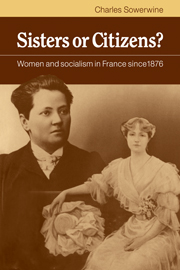Book contents
- Frontmatter
- Contents
- Preface
- Abbreviations of organisations
- Bibliographical abbreviations
- Introduction
- Part I Feminism and socialism 1876–1900
- 1 Women and the beginnings of the socialist movement 1876–82
- 2 Socialist parties in search of women 1882–99
- 3 Feminists in search of a mass base: the rise and fall of social feminism 1889–1900
- Part II Origins of the socialist women's movement 1899–1914
- Part III Development and decline of the socialist women's movement 1914–79
- Conclusion
- Appendix 1 The Second International and the woman question 1889–1904
- Appendix 2 French socialist women in figures
- Appendix 3 Elisabeth Renaud and the Cambier affair
- Notes
- Bibliography
- Index
1 - Women and the beginnings of the socialist movement 1876–82
Published online by Cambridge University Press: 07 October 2011
- Frontmatter
- Contents
- Preface
- Abbreviations of organisations
- Bibliographical abbreviations
- Introduction
- Part I Feminism and socialism 1876–1900
- 1 Women and the beginnings of the socialist movement 1876–82
- 2 Socialist parties in search of women 1882–99
- 3 Feminists in search of a mass base: the rise and fall of social feminism 1889–1900
- Part II Origins of the socialist women's movement 1899–1914
- Part III Development and decline of the socialist women's movement 1914–79
- Conclusion
- Appendix 1 The Second International and the woman question 1889–1904
- Appendix 2 French socialist women in figures
- Appendix 3 Elisabeth Renaud and the Cambier affair
- Notes
- Bibliography
- Index
Summary
In the early years of the Third Republic, there was no socialist movement, let alone an organised socialist party. There had grown up during the 1840s what the French called the ‘social movement’, but this broad term designated all those who sought greater social justice, from republicans and Freemasons to syndicalists and members of the International. The social movement was painfully reconstituted during the Second Empire, only to be crushed again. The repression of the Commune deprived the social movement of its working-class leaders and many of its followers in Paris, the traditional centre of the movement. In the decade following the Commune, a more specifically working-class movement began to emerge through a series of congresses which laid the basis for the parties which, during the following decade, became known as ‘socialist’ and began to distinguish themselves from the republicans.
The social movement of the Second Empire had not been notable for its support of women's rights. Although the Utopian socialists of the 1840s, like Cabet and Fourier, had been ardent champions of equality between the sexes, the sentiments of most republican and working-class militants in regard to women's roles were probably better expressed by Proudhon. In the 1870s, nothing indicated that the social movement if reconstituted would take a stand for women's equality with men.
- Type
- Chapter
- Information
- Sisters or Citizens?Women and Socialism in France since 1876, pp. 21 - 47Publisher: Cambridge University PressPrint publication year: 1982
- 1
- Cited by



